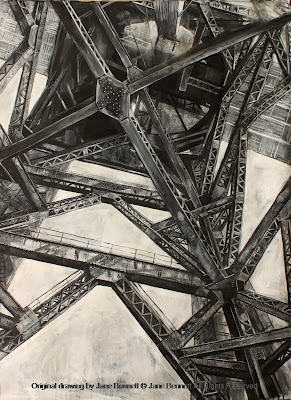
Starting my painting of the
'Excavation between Harris and Mount Streets, Pyrmont'
2017 oil on canvas 51 x 61cm
Available
Not far south of the Terminus Hotel, another formerly ignored and derelict site is being gentrified.
There was a 'no man's land' between Harris and Mount streets which was an overgrown wasteland, with the southern end used as a carpark for the past 3 decades.

P241B 'Panorama from the roof of Pyrmont Power Station
from Harris St, Mount St to the CSR Distillery'
1991 oil on canvas 31 x 61cm
Available
This is a small canvas I painted from the roof of the Chem-Lab of the Pyrmont Power Station in 1991, looking west towards the ethanol tanks of the CSR Distillery. In the centre is the handsome vine-covered Federation building that was once the house of the CSR Manager. The carpark can be seen to the right of the Manager's house.
Clumps of pampas grass used to poke through the badly laid bitumen, which was covered with weeds and strewn with discarded bongs.
This wasteland occasionally featured as a backdrop for early 1980s rock video clips.
Only a brick pier wall facing Mount st and a tumbledown graffitied sandstone block wall remained above ground level as relics of the row of terraces once occupying that site. The terraces had been pulled down long before I started to paint in Pyrmont.

Starting my painting of the
'Excavation between Harris and Mount Streets, Pyrmont'
2017 oil on canvas 51 x 61cm
Available
The carpark has now been excavated, revealing the golden sandstone beneath. This is one of the few remaining still undeveloped sites in Pyrmont, and I took the rare opportunity to paint the honey coloured tones of the yellowblock sandstone before it is removed and construction starts.
It isn't far from the McCaffery's stables, which had been built over the legendary 'Paradise Quarry', where the best quality sandstone in Sydney had been extracted.

Starting my painting of the
'Excavation between Harris and Mount Streets, Pyrmont'
2017 oil on canvas 51 x 61cm
Available
Under the bitumen, an archaeologist's dig had revealed a cobbled sandstone path, a neatly finished sandstone cesspit, carved sandstone steps and mysterious carvings. One of the carved images resembled a child-like version of a church or chapel. Paul Gye aka 'Pyrmonstrosity Pyrmontosis', who has dedicated many hours into painstakingly and expertly researching Pyrmont's hidden history, has concluded that these carvings might have dated from as early as 1840 and could refer to Dr JD Lang’s Presbyterian ‘Long Lost Chapel of Pyrmont’. The full album of photos of 'Pyrmonstrosity Pyrmontosis' site visit with photos of the carvings can be seen at Facebook album : Archaeological Site Visit - Mount & Harris Streets - 10 May 2017
The chapel was later relocated to Ultimo, and its current location is the 'Mustard Seed' ministry in Bulwara Street (ironically opposite the Lord Wolseley Hotel).
Unfortunately despite their unique heritage value, the carvings have by now been completely destroyed by the excavation.

Starting my painting of the
'Excavation between Harris and Mount Streets, Pyrmont'
2017 oil on canvas 51 x 61cm
Available
During my site visit, I tried to persuade the archaeologists to let me paint on site before the demolition started, but they gave me the brush off, no pun intended.
Frustratingly I had to peer through the hoardings and shadecloth.

Starting my painting of the
'Excavation between Harris and Mount Streets, Pyrmont'
2017 oil on canvas 51 x 61cm
Available
The 2,300sq metre site on the south-western side of the Terminus Hotel, will be soon transformed into a collection of 15 low-rise terrace houses, aka the 'New Life Pyrmont' project.

My painting of the
'Excavation between Harris and Mount Streets, Pyrmont'
2017 oil on canvas 51 x 61cm
Available
I persuaded a kind passer-by to hold up my painting so I could take a good photo of it against the demolition.
The top half of the stairs once leading from Harris Street to the carpark have already been demolished, and the Harris Street frontage has been completely excavated and removed to allow trucks to enter and remove the sandstone.
I've heard that the terraces have been designed to incorporate some of the excavated sandstone from the site.
For more information see My Pyrmont page in this blog
Related posts
Looking over the overlooked-Urban decay in Pyrmont
To the Point
Wrong side of the tracks - Darling Island Bond and Free
Pyrmont Paintings past and present
Paintings of Pink pubs - Painting the Jolly Frog Part 2
























